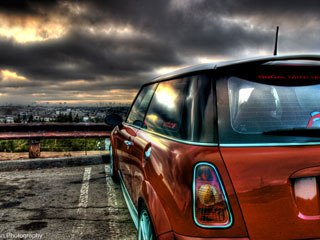Digital Domain vfx artist Brad Herman describes what it was like working on two Oscar-nominated movies, Transformers and Pirates of the Caribbean: At Worlds End, with Massive as his specialty.
Transformers and Pirates of the Caribbean: At Worlds End. Its not every vfx artist that gets to work on two Oscar-nominated movies in the same year. But 28-year-old Brad Herman is enjoying a good run at Venice-based Digital Domain, where hes currently working as simulation lead on one of this years most anticipated releases, Speed Racer, the first directorial effort by the Wachowskis since The Matrix trilogy.
On both Transformers and At Worlds End, Hermans expertise in creating crowd effects with Massive and in building organizational pipelines came in handy. In fact, on the latter, Herman was called in to create the armada of ships, complete with individual crews. He began by assembling animation from previous projects to build a pirate army to crew the ships.
We ended up using all the motions that we already had, but modifying them inside of Massive to make it look like they were doing things on the ships, he says. A bit of custom animation was added to make some pirates do specific tasks, like climbing scaffolding, and the crews were added to more than a dozen different ships. Different versions of those ships were created by altering textures all through the background of the shots to create the final sequence.
The first ship you have is real, the second ship is usually greenscreen and the third ship in back is Massive people, he adds.
Transformers was a dream job for Herman, who grew up a fan of the robots in disguise. Its Transformers! How could you not want to work on it?
Hermans main job on the film was solving problems and he worked primarily on setting up the pipeline and the trailers -- in particular, the trailers morphing logo, which came to him as a file created by another effects company for another trailer.
I dont even know how many pieces of software they went through to actually make this. We got a Maya file in the end, but as far as we could tell, Max was involved at a couple of steps, he suggests. He worked about three weeks on the file, which had about 1.5 million points and even more polygons. I had to dissect it and sit there and build scripts, and basically find a way to move a million-and-a-half points of deforming data from Maya to Houdini and get it to load and be renderable and lightable. And I had start some textural work so it looked like metal for the director.
As for Speed Racer, due May 9 from Warner Bros., Herman confirms his title is simulation lead -- but can say little else about the film. What Im simulating I cant say, but its cool, he teases.
One can surmise, however, that it pertains to the virtual world behind the thrilling car chases. Reports indicate the film will use 2½-D technology and high-definition digital video to recreate the feeling of the original anime in live action. A recent trailer featured a tantalizing glimpse of a hyper-colorful and energetic vision that forges a new direction for next-gen moviemaking.
Things like Sin City and 300 paved the way for people to understand that film doesnt have to look a certain way, Herman says of the general approach to the film. Were not stuck in the old archetypes, and some of the old archetypes are fantastic -- I mean, I love film noir -- but new ones can be created. I think the trailer showed you the kind of direction theyre going with that.
All this is a logical realization of the dream Herman had growing up in suburban Philadelphia. Describing himself as the town nerd, he says he knew he wanted to do visual effects at age 11, a decision prompted by his realization that the effects on TV shows Seaquest DSV and Babylon 5 were created on the same LightWave unit he used at a now-defunct local after-school program called Cinekyd. I had the same video toaster in front of me in class that they were using out here to make those shows. And the only difference was that they had more skill than I had, he offers.
Hermans effects for Cinekyd projects led to him getting his first paying gig at age 16, making digital models of furniture with OpenGL for interactive kiosks at IKEA. My mothers very fond of the joke that it was the only time I made a bed in my life, he says.
Herman took his extensive high-school experience in visual effects to the Academy of Art in San Francisco, testing out of most of the computer requirements for a degree. After a year and a semester, he was offered a job by one of his instructors working at Broderbund laying out UV maps for videogames. I basically looked at it as I could keep paying X amount for college, or I could start making X times 1.5, he continues. And I chose to start making money instead of going more into debt.

After a year in games, Herman moved to Los Angeles to a job at Flat Earth working on the animated Roughnecks: The Starship Troopers Chronicles TV series. Herman describes the show as a nexus of sorts for vfx artists who used LightWave at the time. If youre my age and in the LightWave community, theres like an 85% chance you worked on that series, he suggests.
The series lasted only one season, but this was the project that Herman says allowed him to cut his teeth. The show required six- and seven-day work weeks, going 16 hours a day to produce the 20 minutes of animation needed for each show every four weeks.
When the end of the show came quickly, a co-worker brought Herman over to Digital Domain, where he worked on several commercials and got his first feature work on Red Planet and X-Men.
Thats when I started learning scripting, programming, expressions and started my transition to now, he insists. It was a lot about finding a way to separate myself from the pack as well, just so that Id have more marketable skills because marketable skills are what get you hired. And it was the first time I did crowd stuff.
Herman also learned to separate the personal from the business side in negotiating contracts and adapting to the cycles of the industry when a downturn prompted Digital Domain to cut back. Herman jumped around to a number of boutique houses, working on films as different as Daredevil, Agent Cody Banks, Minority Report and Jay and Silent Bob Strike Back, on which he did his first compositing work.
At smaller shops, youre going to find yourself being modeling, texturing, tracking, comping -- youve got to be able to do everything or theyre going to hire somebody else, he emphasizes.
Another important skill is to develop a thick skin. Somebodys going to sit there and theyre not going to like something that you did. It happens to everybody. And theyre going to go and just scream at it up one side and down the other. And the first time that happens, its tough to take because you take it personally.
What led Herman back to Digital Domain was an ambitious project called Stealth. Despite being a bomb at the box office, the project was an important one for Herman, who worked two-and-a-half years on the film.
I still hold those visual effects up against anything, he suggests. Herman says he headed up the team that created the ground environments and basic sky for the film, using Terragen, which he calls one of the more elegant pieces of software Ive ever worked in. A big part of that was the programs ability to handle shader trees that had as many as 1,700 nodes for a single shot.
From there, he moved on to Flags of Our Fathers and Letters from Iwo Jima, two films Herman is quite proud of.
While being the father of a three-month-old boy has cut into his movie-going time, Herman says he admired greatly the visual effects done on 300 and is especially looking forward to Zack Snyders take on Watchmen next year. He also makes time to re-read two favorite books about once a year: the Orson Scott Card novel Enders Game and Frank Millers The Dark Knight Returns.
When it comes to favorite tools, Herman is quick to sing the praises of the scripting language Python. Its easy to learn, its very friendly and its white-space delimited, which means that its almost impossible to write hard-to-read code, he adds. Herman also cites the spread of the language to applications such as Houdini and Maya as another advantage. A unified scripting language across most visual effects software will I think be a huge boon to technical directors like myself.
Herman says he uses Houdini and Maya for 3D work and goes with Nuke and Photoshop for 2D. Since he specializes in crowds, Herman also uses Massive a lot and hopes that some of what he's done with it has broadened the horizon of what it's possible to do with the program. He still enjoys the creative freedom at Digital Domain, which is experiencing a renaissance under new ownership and management comprised of former ILMers. In fact, Herman has formed a photography group at work whose membership has grown to 60.
As for the state of visual effects, Herman says digital cinema's replacement of film has had a huge impact. "You have to be much more careful about what you show" he cautions. "And you have to be much more nitpicky about every small detail. Now, it's all about the 2K playback and whether someone at home will see it when they're stopping their DVD."
Thomas J. McLean is a freelance journalist whose articles have appeared in Variety, Below the Line, Animation Magazine and Publishers Weekly. He writes a comicbook blog for Variety.com called Bags and Boards, and is the author of Mutant Cinema: The X-Men Trilogy from Comics to Screen, forthcoming from Sequart.com Books.











